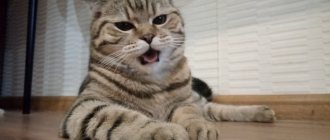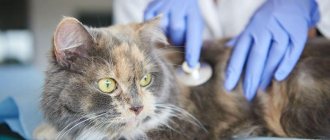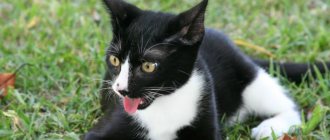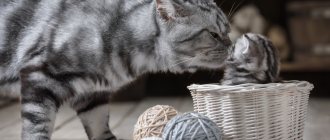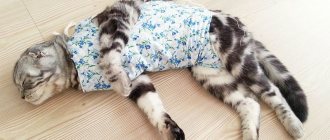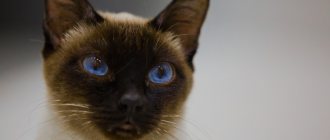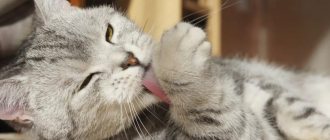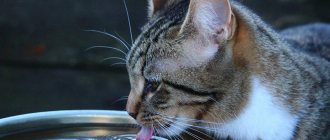Why is the cat snoring?
The respiratory system of cats is similar to humans. Our pets can sigh, sniffle and even snore in the same way. Most often this happens in a dream. Dreams of cats can consist of various events that cause an external reaction not only in the form of twitching their paws, as if the animal is running, shuddering, but also reactions of the respiratory system.
But if a cat or kitten sniffles not only during sleep, but also when awake, this may indicate the appearance of health problems. In this case, the owners need to more carefully observe the pet, which sniffles when it breathes, and track the duration and frequency of the snoring. This can help in determining the cause of the condition, and in deciding what to do and how to treat the animal.
The most common causes of cat snoring:
- Swelling of the larynx. Most often it occurs due to allergies or foreign objects in the respiratory system. It can be detected during a medical examination and during x-rays.
- Asthma.
- Urolithiasis disease. Snorting may be accompanied by wheezing.
- Parasites. Worms can be found in any organ, including the respiratory system.
- Pneumonia and bronchitis.
- Rhinitis.
- Respiratory infections.
- Heart failure. In addition to snoring, coughing and blue discoloration of mucous membranes are observed.
- Obesity.
Paroxysmal breathing
This is the name of an interesting pathology when a cat makes very strange sounds during attacks, which can be described as “something in between” sneezing, grunting and trying to inhale more air. How can you determine if your pet has this disorder? It's quite simple: the cat slightly bends its front legs, arches its back, and its eyes are wide open. We have already written about the sounds it makes at this time.
What should the owner do? After all, the cat, it seems, is far from delighted with his condition! No matter how strange it may seem to you, the first thing you should do is calm down. Yes, paroxysmal breathing does not look very pleasant from the outside, but in many cases it does not pose a real threat to the life and health of the animal
.
True, sometimes you should be wary:
- If attacks, which were relatively rare and short-lived, acquire an unpleasant tendency to become more frequent.
- During “oddities,” the cat begins to vomit, and sometimes blood clots can be easily seen in the vomit.
- Your pet has begun to sleep very poorly and restlessly: the cat grunts through its nose, which is why it often wakes up. You need to take a closer look at it if your pet belongs to any of the brachycephalic breeds we have already mentioned.
In the latter case, it is possible that your pet needs the
operation we have already described to “shorten” the palatal tissues
. If everything is not so serious, but you want to help your pet, gently massage his throat after attacks, and also give him plenty of warm water. All this will soften irritated tissues and stop an attack of “grunting”.
Diagnosis and treatment
Periodic snoring is normal for humans and animals. If this happens rarely, it should not be a cause for concern. But if it's a cat sniffling while breathing all the time, or even breathing with its mouth open, it should be a cause for concern. Persistent breathing problems can lead to more serious health problems. Most likely, you will need a veterinarian's consultation and treatment, because... It is difficult or even impossible to independently determine the disease. But before contacting a doctor, it is necessary to observe an animal that is sniffling and breathing heavily. To make a diagnosis, exclude various diseases and prescribe the correct treatment, the doctor will need detailed information.
The main reasons for “snorting”
Snorting is another way for an animal to clear its nasal passages. Unlike sneezing, this action is not performed reflexively, but consciously, like a human blowing his nose. If the cat rubs its nose with its paws, it means it is experiencing discomfort. The reason for all these actions may be:
- the beginning of a runny nose, when there is no discharge yet, but there is a burning and itching sensation in the nose;
- entry of irritating substances or particles into the nasal passages;
- foreign body in the nasal passages;
- inflammation of the paranasal sinuses (sinusitis);
- inflammation of the tooth root (pain may be felt in the nasal area).
Why does a cat sniffle when breathing?
A cat's wheezing and snoring indicate abnormalities in its body. They can be caused both by the characteristics of the breed and congenital pathologies, and by various diseases. If such symptoms occur, it is necessary to examine your pet. If there are no signs of deterioration in health, there is no reason to panic. If general malaise and other symptoms appear, the animal should be taken to a veterinarian.
Owners sometimes notice that their pet snores in his sleep, and when awake, his breathing seems labored, with hoarseness or wheezing. There are many reasons for this phenomenon, from the most harmless to the potentially fatal.
The structure of a cat's respiratory system is similar to that of a human. Between the nose and the lungs are the nasopharynx, bronchi and trachea. Breathing provides the entire body with oxygen and ventilation of the lungs from waste gases. If atypical sounds are observed during this process, it is necessary to show the animal to a veterinarian.
Impaired respiratory functions can be caused by causes that are not directly related to diseases that have pulmonary pathogenesis (edema, fibrosis, pneumonia), but are no less dangerous for the pet’s life. Failure of gas exchange in the body can be caused by:
- brain and spinal cord injuries;
- an inflammatory process affecting the central nervous system;
- heart failure;
- foreign objects caught in the nasopharynx.
Associated symptoms of a serious illness will be changes in the animal’s behavior:
- passivity;
- loss of appetite;
- purulent or foamy discharge from the nose and mouth when breathing;
- pale blueness of the mucous membrane.
Contacting a veterinarian is mandatory and urgent.
When a kitten, cat or cat sniffles, but does not show signs of pain, behaves naturally, plays, and does not lose appetite, it is worth conducting an accessible examination of the animal:
- 1. If the pet’s mucous membrane has a healthy pinkish color, the body does not lack oxygen.
- 2. The absence of nasal discharge excludes colds.
- 3. Light pressure along the entire length of the back will help determine the presence (absence) of areas of pain.
Hoarse breathing can be caused by a deviated nasal septum or obesity, which is no more dangerous for a cat than for a person.
If your pet is wheezing, scratching, or sneezing, the disorder may be caused by an allergic reaction. This condition develops in pets due to:
- household chemicals;
- synthetic materials (flooring, wall decoration);
- stern;
- mineral toilet filler.
In this case, it is necessary to isolate the animal from the allergen. Antihistamines can be used, but should not be overused.
In short-faced exotic cats, snoring is caused by physical features, that is, a short nose. Exotics and their crossbreeds are also characterized by a heart muscle defect.
Pulmonary causes of wheezing
Pulmonary causes can be associated with inflammatory processes in the bronchi and lungs of an allergic and non-allergic nature, and with respiratory tract injuries (foreign body entry, hematomas, pneumohydrothorax, diaphragmatic hernia).
Cats do not get the flu or ARVI. But they have their own viral infections (rhinotracheitis, calcivirosis), which can cause the animal to cough and wheeze.
Rhinotracheitis and calcivirosis
Both diseases are viral in nature and are quite dangerous for cats. Both are accompanied by damage to the mucous membranes of the respiratory tract and intestines. They occur with high fever, diarrhea (in severe cases with dehydration), cough and wheezing. With calcivirosis, the cat's visible mucous membranes and tongue are ulcerated. With rhinotracheitis, there is abundant mucopurulent discharge from the eyes and nose.
Pneumonia
This disease in cats can be bacterial, viral or fungal in nature. At first, a strong “barking” cough appears, as if scratching the airways, and the temperature rises. Then the cough becomes wet with wheezing of large or fine bubbles. The general condition of the animal is impaired.
Bronchial asthma
An animal with this pathology takes a characteristic position: presses against the floor, stretches its neck, makes wheezing sounds, and sometimes coughs. In severe cases, expiratory shortness of breath up to suffocation is observed. With asthma, owners often believe that their animal is choking, which is why it wheezes.
Helminthiasis
Wheezing, similar to symptoms of bronchial asthma, can be caused by the migration of parasites. The most common diseases found in cats are aleurostrongylosis (more common in America) and dirofilariasis.
Oncology
Tumors of the respiratory tract can be benign and malignant, primary and metastatic. Oncopathology of the respiratory system is less common in cats than in dogs. Older animals get sick more often. The development of a tumor in any part of the respiratory tract can cause breathing problems and wheezing. The most common signs of growth of a tumor in the larynx are impaired breathing, difficulty, hoarseness and changes in voice. The pet's voice becomes squeaky or hoarse. The disease is accompanied by shortness of breath and cough, sometimes mixed with blood.
Brachycephalic syndrome
The disease involves pathological growth of the tissues of the velum and narrowing of the nasal passages. The animal wheezes and wheezes heavily. He sleeps with his mouth open and snores. He eats normally. Remains active.
Laryngeal edema, laryngospasm
This condition can develop as a result of poisoning with household chemicals, allergies to inhaled dust, tobacco smoke, strong aromas, etc., an autoimmune reaction. Much less often, mechanical damage to a cat’s larynx leads to laryngospasm. At the same time, the animal’s body feels an acute lack of oxygen and stress hormones are released. The cat is frightened, wheezes and wheezes heavily, breathes with difficulty, whistling, and screams in a “bad” voice.
Pneumo- and hydrothorax
Develops as a result of rupture of the lungs by a tumor, open wound or closed injury. The pet's breathing is difficult, he sits with his mouth wide open, breathes with difficulty and hoarsely, and is very scared.
Inhalation of a foreign object
A foreign body can get stuck in the animal’s pharynx, trachea and bronchi. It may be small and move along the bronchial tree, causing bouts of repeated coughing and wheezing. Or large and block the airways partially (working as a valve) or completely. In this case, the animal coughs, wheezes heavily, rubs its neck on objects, and mucous-foamy sputum, sometimes mixed with blood, is released from the nose. The animal does not drink, does not eat and may suffocate.
Pulmonary edema
Pulmonary edema can be caused by a variety of diseases of internal organs, injuries and inflammation of the lungs, aspiration of vomit, water, and small objects. The cat takes a forced position, breathes hoarsely, with difficulty, pink foam comes out of its nose, and its sides swell.
Congenital pathologies
Narrowing of the nasal passages, an elongated soft palate, and polyps can cause breathing problems and hoarse sounds heard when the animal breathes, especially after exercise.
Tracheal collapse
At the initial stage, it does not cause any particular concern to the animal. Manifests itself in the form of a cough during a strong emotional outburst. Over time, the condition worsens, hoarse breathing appears, shortness of breath, and the cough intensifies.
The reason why a cat snores loudly when breathing
The respiratory system of cats is similar in structure to that of humans. They, just like humans, can sigh, grunt and even snore. If a cat sniffles not only in his sleep, this may be a symptom of an illness.
The animal begins to sniffle as a result of inflammation of the nasopharyngeal mucosa. This happens due to hypothermia or a cold.
The respiratory system of cats is similar to humans
A pet's runny nose often occurs as a result of exposure to chemicals. Rhinitis can be a consequence of any previous disease.
In addition, the pet looks apathetic, there is exhaustion, and the development of conjunctivitis.
In case of a cold or rhinitis, treatment must be carried out to avoid negative consequences.
Causes of nasal congestion?
Pets, particularly cats, are susceptible to many infectious diseases; they can catch colds due to a draft or resting on a cold floor. Diseases can be infectious or respiratory. If a cat sniffles, the reasons may be related to the disease
, the beginning of the inflammatory process in the mucous membrane.
Rhinitis, rhinotracheitis, and the presence of feline herpes can be diagnosed by a veterinarian. He will tell you how to clean a cat’s nose to make breathing easier, and he will tell you how to treat the disease.
ATTENTION!
With nasal congestion, it is difficult for a cat to assess its surroundings, because this organ is of great importance for orientation in space, finding food, and recognizing danger.
When an animal's nose is clogged and grunts, its existence is filled with a feeling of discomfort. And the owner is looking for an answer on how to wash a kitten or an adult pet’s olfactory organ. But first you need to establish the cause of the malaise:
If a runny nose accompanies nasal congestion, chronic sluggish rhinitis is most likely due to a decrease in immune potential.
IMPORTANT!
Particularly dangerous causes of nasal congestion are cat diseases such as calcivirosis, peritonitis, leukemia, viral pneumonia, feline herpes, and purulent conjunctivitis. Therefore, there is no need to hesitate to visit the veterinarian and self-medicate.
If a cat does not breathe through its nose, it may have a severe allergy to hot steam, household chemicals, pollen, and chemicals.
. Allergic reactions are typical for purebred cats, but they can be an individual feature of even a domestic animal. At the same time, the cat may have noticeable discharge, like a runny nose, the pet sneezes and snorts.
Normal cat condition
If your feline pet sniffles, but does not express any pain, his behavior has not changed, he plays, eats well, you need to examine the animal:
- if the nasal mucosa is pink, then the body receives enough oxygen;
- there is no discharge from the nose, which means a cold is excluded;
- Light pressure over the entire back will help determine whether there are or are no areas of pain.
When your cat sniffles, she also scratches her nose with her paws and sneezes; perhaps she just has an allergy, which will disappear after the allergen is eliminated.
Periodic snoring is normal for humans and animals.
Cat has a runny nose
Often cat owners are faced with a pet disease such as rhinitis
. The cat suffers from a runny nose and a stuffy nose, because it loses its unique ability to accurately and quickly navigate the environment and recognize danger. What manifestations of rhinitis can be noticed?
- The animal not only has difficulty breathing through its nose, it cannot run or play calmly. It also becomes more lethargic, detached, loses appetite, and looks depressed.
- You can see the cat scratching its nose with its paw, fiddling with it, trying to clear it of congestion.
- Sometimes the temperature rises, even up to 39 degrees. If you touch your pet's nose, you can notice how hot it has become.
- Another sign of rhinitis can be conjunctivitis. It is necessary to wash the animal’s eyes so as not to aggravate the inflammation.
Possible diseases and pathologies
When your pet snores constantly, or very often, it may be a symptom of one of the following conditions:
- swelling of the larynx; may be caused by allergies, or the presence of foreign objects in the respiratory system;
- urolithiasis disease; snoring is sometimes accompanied by wheezing;
- the presence of worms, which may even be present in the respiratory system;
- asthma;
- rhinitis;
- pneumonia and bronchitis;
- heart failure; along with wheezing, a cough and blue discoloration of the mucous membranes can be observed;
- respiratory tract infections;
- obesity.
When snoring is not a breed trait
In some cases, sounds in sleep may be a sign of a pathology that does not depend on the breed. You should be wary if:
- snoring or glanding is too loud;
- it is difficult for the animal to breathe, it opens its mouth;
- there was no snoring before (or it was not so strong) and it started recently;
- in addition to snoring, there are other respiratory manifestations (runny nose, sneezing);
- When snoring, whistles and abnormal sounds are heard (here the answer to the question of why a fold-eared cat wheezes will definitely not be a breed feature).
In such cases, the cause of snoring, snoring and wheezing may be the following pathologies.
Cold
One of the most common causes of snoring and glanders in cats is a common cold with a runny nose. The nose secretes abundant mucus, which clogs the passages, causing the air to flow with difficulty and unevenly, causing characteristic sounds.
Low indoor air humidity contributes to the occurrence of respiratory diseases in cats and people. A moistened mucous membrane is less susceptible to infection by viruses and bacteria, because can give an adequate immune response. Therefore, as a preventative measure, the air in the room needs to be humidified using special devices.
If an animal catches a cold under the air conditioning or catches a weak virus, the immune system will most likely cope with it itself. But if the condition worsens or does not go away for several days, or if other symptoms of the disease are noticeable, you should consult a veterinarian.
Lung problem
Moist wheezing as you inhale and exhale or a cracking sound as you inhale may indicate a lung problem. In the first case, the cause of wheezing is sputum, in the second - pathology of the alveoli. Put your ear to the cat's chest: does the sound come from there? If yes, you need to go to the veterinary clinic.
Edema
Swelling of the mucous membrane of the throat or bronchi causes dry wheezing when inhaling. If they are accompanied by a whistle during inhalation and exhalation, this indicates mild swelling of the larynx. It usually occurs due to allergies and a foreign object getting into the throat.
If swelling occurs, contact your veterinarian immediately. It is dangerous to treat this condition on your own.
Obesity
Obesity is a disease that entails other pathologies. In particular, it puts a strain on the heart muscle, as a result of which a chain of pathological reactions ultimately causes such an external manifestation as snoring.
Asthma
Asthma is difficult to miss: it cannot be confused with ordinary snoring. With asthma, a cat experiences asthma attacks not only at night, but also during the day.
Injury
Trauma to the respiratory tract often leads to snoring and wheezing during inhalation and exhalation. If you know that your cat has recently been injured, you should be examined by a veterinarian as soon as possible, because... the condition can be dangerous.
Urolithiasis disease
In rare cases, wheezing in a cat is caused by urolithiasis. If this is the case, it means that there is already intoxication and it is necessary to begin treatment immediately.
Before this, urine is tested. The analysis will reveal the inflammatory process and sand. A number of other studies are also carried out, after which treatment is prescribed. Read more about urolithiasis.
Worms
Eggs and larvae of helminths can enter various organs through the bloodstream, including the respiratory tract. A blockage occurs and, as a result, the cat snores.
Heart failure
Heart failure is accompanied by the so-called cardiac cough, cyanosis of the mucous membranes and dry wheezing during inhalation and exhalation. Sometimes wheezing is one of the few manifestations of the disease, so wheezing cats that are overweight or of advanced age must be checked for this pathology.
Unfortunately, sometimes this pathology is not always noticeable. It happens that an apparently perfectly healthy cat unexpectedly dies in its sleep. Therefore, it is advisable for all cats who sometimes sniffle and this is not associated with respiratory infections, as well as those who experience shortness of breath, to be regularly checked by a veterinarian.
When to take your cat to the vet
If your cat sniffles frequently or breathes with her mouth open, this should alert you and cause a visit to the veterinarian. Before consulting a doctor, you need to observe the animal for a couple of days in order to correctly answer questions at the veterinary clinic to make the correct diagnosis. The veterinarian may be interested in the following information:
- how long ago did the snoring begin?
- are there any accompanying sounds along with wheezing during breathing;
- whether the pet was injured;
- whether the animal’s usual behavior has changed;
- was there a change in the color of the mucous membranes;
- other symptoms (vomiting, runny nose, cough).
Persistent breathing problems can lead to more serious health problems
By the nature of the snoring and additional sounds, you can determine the source of the disease:
- wheezing, coughing and blue mucous membranes signal heart failure;
- wheezing and wheezing indicate the presence of urolithiasis;
- wet rales may indicate phlegm in the respiratory system;
- crackling indicates problems in the alveoli;
- dry wheezing indicates the presence of edema in the bronchi or larynx;
- sniffling plus whistling may indicate swelling in the airway area.
A correct diagnosis and timely initiation of treatment will ensure a speedy recovery for the cat. There is no need to rely on the advice of other cat owners or information on websites. Each case is individual, even if the symptoms are similar.
Signs and types of wheezing
Wheezing is not just one sound. This is a whole combination of noise, each option corresponds to a specific group of pathologies.
Wheezing is usually classified into:
- wet;
- dry;
- crepitant;
- whistling.
Wet wheezing sounds appear due to the accumulation of mucus (phlegm) in the bronchi of the cat. Sputum is produced in large quantities as a result of inflammatory processes affecting the bronchial tree. The air inhaled by the animal passes through the mucus, bubbles form, which then burst. This is what causes wheezing. Moist rales are divided into small-, medium-, and large-bubble.
The first accompany the collapse of small bubbles formed by sputum. May occur with pulmonary infarction or bronchopneumonia. The latter resemble the sound of air blown through a straw. They occur when there is hypersecretion of mucus as a result of bronchitis, fibrotic changes in the lungs or pneumosclerosis.
The latter type of wheezing is clearly audible even without a stethoscope and occurs due to the accumulation of exudate in the lungs with a weak cough reflex or pulmonary edema.
Dry noises are divided into whistling and buzzing.
They arise due to narrowing of the lumen of the bronchi as a result of obstruction, mechanical compression by the tumor and the development of an allergic reaction. The air swirls and has difficulty squeezing through the narrow gap, which creates noise. When air passes through the unevenly narrowed bronchi, the sound becomes whistling. If there is viscous mucus in the bronchi, the mucous membranes block the path of air. And the breath passes with a slight buzzing sound, as if the air is squeezing through a narrow and half-covered hole.
Brachycephalic cat breeds: when shortness of breath is a consequence of illness
In some cat breeds, shortness of breath is very common. These are breeds with skulls affected by brachycephaly.
Brachycephaly is a genetic disorder that causes difficulty breathing, snoring, snoring, snoring, and other related conditions such as watery eyes. Brachycephalic cat breeds are artificially bred, and many owners believe that the flattened face is an attractive feature, despite the negative health consequences.
There are 5 common breeds of flat-faced cats:
- Persian cat;
- exotic cat;
- Scottish;
- British Shorthair;
- manul
All the negative components of brachycephalic syndrome are aggravated by stress, obesity, respiratory infections, physical activity and overheating. Therefore, it is extremely important to protect the animal from these factors whenever possible.
Due to the structural features of the trachea and larynx, such cats develop respiratory failure and, as a result, fainting. All breeds with a shortened muzzle require increased attention from the owner, regular examinations and constant monitoring by a veterinarian.
Severe snoring (glanders) and a number of accompanying pathological features that seriously impede breathing are called brachycephalic syndrome. This syndrome is typical for cats with small noses and round heads: Persians, Exotics, British and Scottish.
Brachycephalic syndrome can be eliminated surgically, which, however, is not always considered justified. However, there are such manifestations when, due to this syndrome, the cat has cyanosis of the mucous membranes, the airways swell, the load on the heart increases, and after the slightest overheating or physical activity, convulsions develop or the cat loses consciousness. This condition significantly impairs the quality of life and can be fatal, and therefore requires treatment. .
Preventive actions
To prevent the listed diseases, one of the symptoms of which is sniffling and grunting in a pet, the following safety measures must be observed:
- Carry out vaccinations and deworming in a timely manner. Such measures will help avoid the development of infectious diseases and the appearance of parasites.
- If your pet has an allergy, eliminate its sources in the apartment and avoid the cat’s contact with allergens outside the home.
- Avoid overeating. Do not leave uneaten food in the bowl. If you gain excess weight, it is recommended to switch your pet to a low-calorie diet. Sterilized cats and neutered cats must be fed special food.
- Avoid hypothermia and overheating of the pet and drafts.
- Increase the animal’s immunity through the regular use of vitamin and mineral complexes, agreed with the veterinarian.
- Conduct regular preventive veterinary examinations to promptly identify existing diseases.
- Start eliminating signs of pathologies immediately after they are identified.
Breathing problems can occur for a variety of reasons.
Cats are capable of making a wide range of sounds: purring, growling, howling, whining. But such performances are usually a reaction to external or internal stimuli. In a calm state and in sleep, the animal behaves quietly. If the owner begins to notice that the cat is wheezing, grunting or making other unusual sounds when breathing, it is worth taking it to the veterinarian. You should not postpone a visit to the doctor if there are changes in behavior.
Heavy, rapid breathing, protruding tongue, constantly slightly open mouth are possible symptoms of disorders of varying severity. Here are the main reasons for changes in the functioning of the respiratory system.
How to help your pet depending on the cause of sniffling and grunting?
After identifying the cause of these symptoms and making an accurate diagnosis, the veterinarian will develop a treatment plan. It requires an integrated approach. Therapy is aimed at improving the animal’s condition and relieving signs of the underlying disease. If a four-legged patient has a cough, antitussive drugs (Sinekod, Bronholitin) are used to eliminate it.
For dry cough, expectorant medications (ammonium chloride, Salbutamol) are indicated. When nasal congestion occurs, the nasal passages are washed with saline solution. To relieve inflammation, they resort to rinsing with chamomile decoction. When the listed remedies are powerless, it is recommended to instill any children's drops (Nazivin, Otrivin, Vibrocil).
The main treatment depends on the diagnosis:
- For helminthic infestations, a course of antihelminthic drugs (Milbemax, Stronghold) is indicated.
- When an allergy is diagnosed, its symptoms are relieved with antiallergic drugs (Suprastin, Tavegil). It is important to identify and eliminate the source of the allergic reaction, otherwise treatment will be useless, and attacks of this disease will appear again and again.
- For infectious diseases, antibiotics or antiviral agents are prescribed.
- Symptoms of heart failure are eliminated with the help of glycosides and potassium-containing medications.
- For injuries of the chest, spine, and ribs, immobilization, antibiotic therapy, and painkillers are indicated.
When it's not snoring at all...
Sometimes owners confuse snoring with rumbling. Half-asleep cats quietly turn on the purr. Listen better!
And sometimes cats have dreams during which they behave excitedly, virtually catching prey or running away from pursuit. At this moment, the cat can also make various interesting sounds and even make movements. But if such dreams haunt your pet every night, while he tosses and turns nervously and makes loud noises, this indicates an overexcited nervous system. This condition requires treatment.
Author of the article Ekaterina Yugosh
— editor of the website “Murkotiki”, a journalist with a felinological education (a felinologist is a specialist who studies cats). She received her felinological education according to the WCF (World Cat Federation) system. She raises a Scottish Straight cat and a Highland Fold cat, as well as a Miniature Schnauzer dog. Her areas of in-depth interests include zoodietology and zoopsychology.
Cats cause endless affection to their owners. This is especially true for the sounds sometimes made by pets - snoring, sighing and even snoring. After all, they are different from ours and seem charming when made by a furry pet. But if the cat wheezes when he breathes constantly, this causes concern and anxiety.
Inflammation of the trachea
It is also “tracheitis”. It occurs due to many reasons, with the leading one being the effect of too low temperatures. Your cat, just like a person, can get very cold in frosty or chilly weather. Hypothermia contributes to the deterioration of the animal’s body’s defenses, as a result of which the rapid growth and development of pathogenic and conditionally pathogenic microflora begins. The logical result is that the animal breathes poorly through its nose, making grunting, wheezing and wheezing sounds. But the main symptom of tracheitis is cough.
